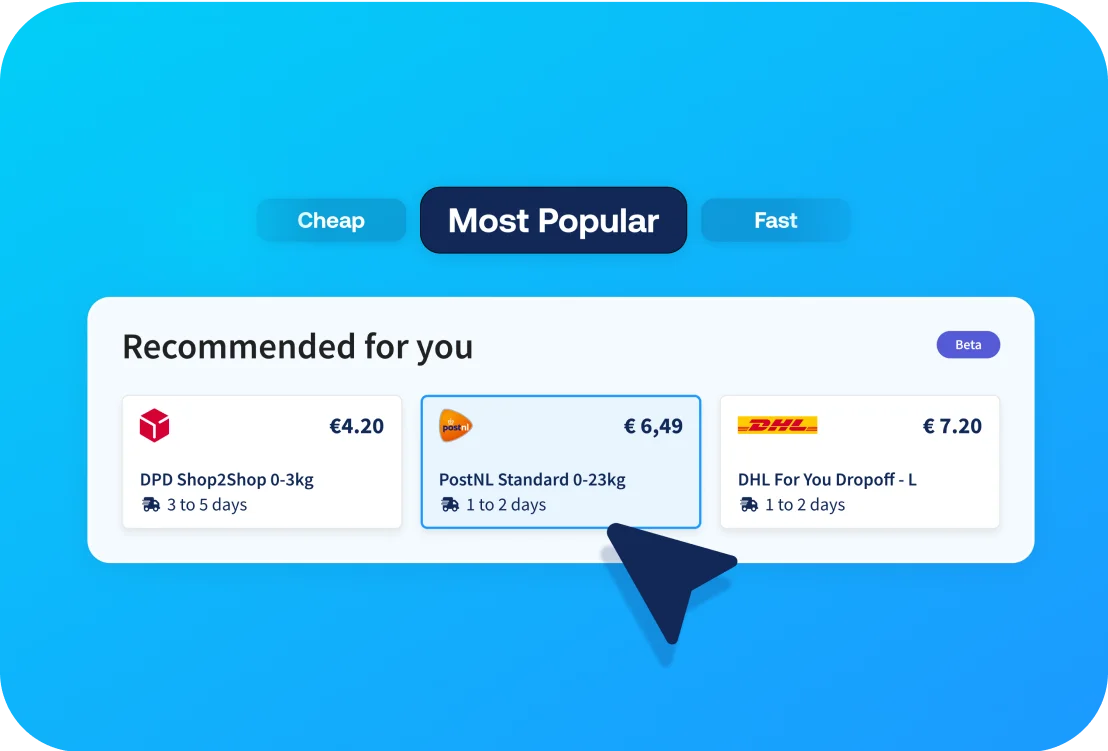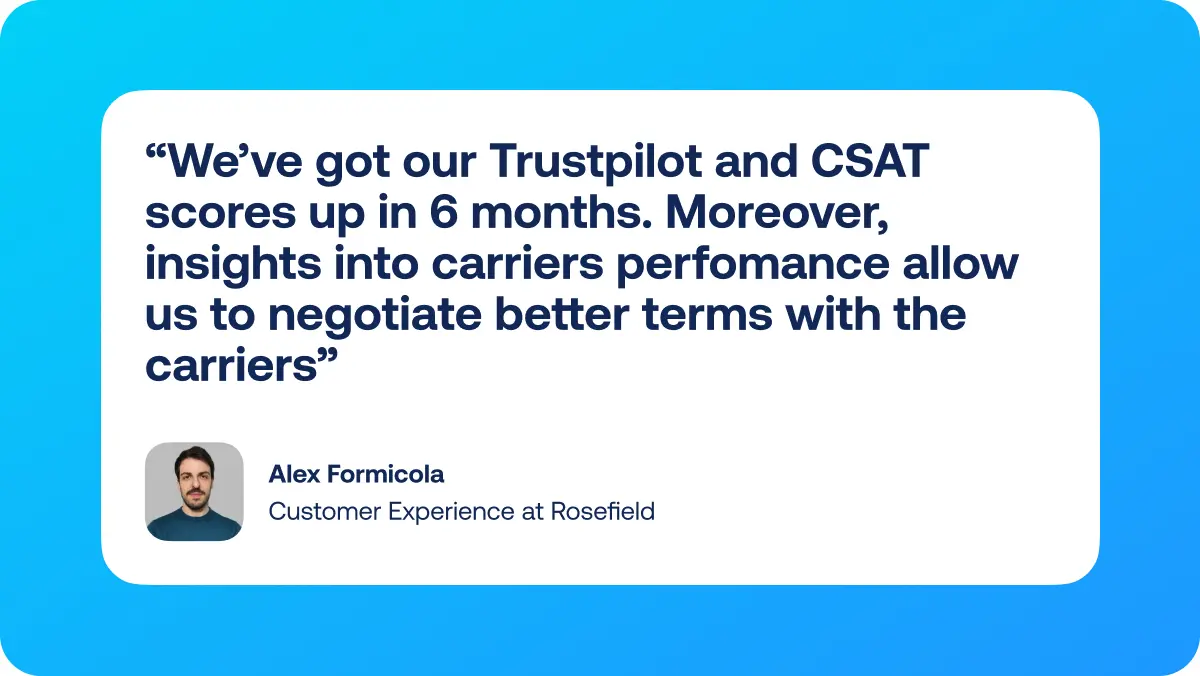Efficient and cost-effective shipping is crucial for large e-commerce businesses. The delivery experience significantly influences customer satisfaction, and shipping costs heavily impact margins. Finding the best carrier rates is therefore essential, but it shouldn’t compromise delivery quality. Discover how to increase your negotiation power for shipping contracts—let’s dive in.
The importance of efficient and cost-effective shipping in e-commerce
With over 26.5 million online stores worldwide, competition in e-commerce is fierce. Giants like Amazon have set high standards for quick and cheap delivery, leading to high customer expectations. Consumers now demand fast, reliable, and affordable shipping options.
On the other hand, shipping costs can have a huge impact on your business’s total revenue. In the clothing and fashion industry, a staggering 12.73% of total revenue is eaten up by shipping costs.
It’s no surprise the need for efficiency, quality, and cost-effectiveness at the same time is sky high. Negotiating carrier contracts should be a top priority. Don’t settle for standard agreements from the past; keep re-evaluating your carrier portfolio and update it according to your shipping profile and e-commerce strategy.
But what exactly should be included in a carrier contract, and what should you aim for? Let’s dive into carrier contracts and provide you with some crucial tips for success.
What is a carrier contract exactly?
In e-commerce, a carrier contract, also known as a shipping contract, is an agreement between an e-commerce business and a shipping or logistics company (the carrier). It outlines the terms and conditions under which the carrier will provide delivery services for the business. This contract is crucial for ensuring a smooth and efficient delivery process to customers.
Key components of a carrier contract
Carrier contracts might differ per carrier, but they generally contain a few key components. Understanding these components helps increase your negotiating power.
- Service levels: Details the types of services offered, including standard and international shipping, along with delivery timeframes and guarantees. It also distinguishes between:
- Premium/Express carriers: Expedited shipping with faster delivery and enhanced tracking.
- Commercial carriers: Efficient and cost-effective bulk shipping for businesses.
- Postal carriers: Government-operated, providing basic shipping with broad coverage but slower delivery.
- Pricing and payment terms: States the cost of shipping, including volume discounts, surcharges, and any other additional fees. It also specifies payment terms such as deadlines and invoicing frequency.
- Liability and insurance: Defines the responsibility for lost, damaged, and delayed shipments and outlines the insurance coverage. It might also give details on the process for filing claims and the documentation required.
- Dimensional weight policies: The rules that carriers apply for calculating shipping charges based on the size of the package.
- Performance metrics: KPIs the carrier must meet, such as on-time delivery and delivery during peak season.
- Duration and termination: Specifies the length of the contract and the conditions under which either party can terminate the contract.
- Service areas: Shares details on the geographic areas where the carrier will provide services.
- Customs and duties: Specifies the responsibilities for handling customs clearings, payment of duties and taxes, and compliance with international shipping regulations.
- Customer service: Outlines the support services the carrier will provide.
What is involved in negotiating shipping contracts?
Carriers are focused on how they can optimize their margins, not yours. This means you need to ensure you’re negotiating for anything that can improve your margins too.
Negotiations go beyond your base shipping rate. Look at the transit times they promise. How are surcharges arranged? Are prices all-inclusive, or do you pay surcharges for additional services? What about price indexes? Consider negotiating a cap on price increases for the duration of the contract.
You can negotiate practically all components of your contract. Here’s how:
- Pricing and discounts: Negotiate lower base rates, secure better discounts for higher shipping volumes, or reduce surcharges. You can also negotiate the penalty for shipping less than initially agreed upon.
- Service levels: If you need faster or more reliable delivery, try to negotiate for that. Pay special attention to first-mile and last-mile shipping, because dropoff or PUDO (Pick-Up Drop-Off) services can be cheaper.
- Parcel volumes and characteristics: Negotiate terms for actual versus dimensional weight and the discounts and fines applied to volume agreements.
- Liability and insurance: Decrease your liability for lost or damaged goods.
- Performance metrics: Negotiate on-time delivery rates and the consequences if the carrier fails to meet them.
- Service areas: For shipping to remote or rural areas, check what can be arranged for these destinations as they can become very expensive under general terms.
- Payment terms: Negotiate billing cycles that best fit your business.
- Returns: Determine what the carrier charges for shipments that need to be returned to the sender.
- Customs and duties: Negotiate responsibilities for customs and duties, and how the carrier supports documentation. This includes understanding different Incoterms like DAP (Delivered At Place), DDU (Delivered Duty Unpaid), and DDP (Delivered Duty Paid). Each term specifies who covers the costs and risks involved in getting goods through customs and to their final destination. This can save a lot of money.
- Customer service: Negotiate the carrier’s response time for shipping issues.
- Contract duration and termination: Include the duration and termination conditions in your negotiation to account for unexpected market or company developments.
Now you know exactly what to negotiate about, let’s have a look at how you can best approach negotiation.
7 tips to negotiate the best e-commerce shipping contracts possible
Negotiating requires proper skills, but always be tough. Having the knowledge and means on how to negotiate carrier contracts can help to arrange the best deal. Here’s a list of practical tips to help you sign contracts that best match your business needs:
1. Understand your shipping profile
The first and perhaps most important tip is to look at your shipping profile. Map out the types of parcels you have, estimate the volumes you expect to ship over a full year, and consider whether you’ll be shipping to any new destinations.
Here’s an overview of elements that make up your shipping profile:
- Shipping costs: What price are you willing and expecting to pay for shipping?
- Customer service: What do you expect from the customer service of the carrier?
- Transit times: What transit times are you willing to accept?
- Market activity: What markets are you active in?
- Product type: What type of products do you sell? Which level of service do I want to offer to my customers?
- Volume expectations: What volume do you expect based on historical parcel volumes?
Next, examine your warehouse setup. Using just one carrier might not be the best idea, especially when shipping to multiple locations. Different customers have different expectations. To meet those, you need to find carriers that align with these expectations.
For example, you might want to consider a more expensive carrier for shipping abroad if they offer faster delivery and better terms for delivery guarantees. When you know exactly what you’re looking for in terms of shipping, it’ll be easier to negotiate the terms that best suit your strategy.
2. Review carrier options and pricing structures
It might sound simple and obvious, but when reviewing carriers, you need to know what to look for exactly. Start with examining first- and last-mile solutions. Are you going to use one carrier for shipping to different regions?
Understand whether you want to ship with a third-party logistics solution that handles picking up your parcels and shipping them as quickly as possible to another country. This approach provides more shipping options, potentially faster transit times, and cheaper rates.
Alternatively, you could use a local carrier that transfers the parcels to another local carrier in a different country, or use carriers with their own international networks and transportation options. When shipping domestically, focus on the services offered and the conditions attached.
Also, keep in mind that not every carrier uses the same pricing structures. It’s crucial to review these pricing structures. Are they all-inclusive or base rates? Examine the yearly price increases and surcharges. Fuel surcharges, for instance, can significantly impact your revenue if you’re not expecting them.
Fuel surcharges are calculated from the carrier’s base fuel rate and applied to some shipping services but not others. Besides fuel surcharges, many other surcharges can influence your shipping rates, such as handling surcharges during peak season or dimensional surcharges.
Make sure to review all potential surcharges before signing a contract and negotiate fixed arrangements to avoid sudden price increases.
3. Use smart shipping data to review disruptions, peak periods and benchmarks
Not sure where to look at different carrier options and performances? Smart shipping data and shipping intelligence are no longer just nice-to-have. You’ll need them to increase negotiation power and evaluate how carriers are performing.
Shipping intelligence uses large, standardized datasets to assess carrier performance over time and offer benchmarks to show how one carrier performs against another. You can compare Lead times (delivery speed), quality, average delayed parcels, resolution times and overall performance.
Comparing carrier performance helps you understand the level of risk you’re willing to take to get cheaper rates or choose a carrier with a higher success rate.
During peak periods, carriers handle almost 50% more parcels than in an average week of the year. Review peak period surcharges and performance simultaneously. In this season, you don’t want to negatively surprise your customers with bad delivery experiences.
4. Use both the total shipping costs and flexibility for negotiations
It’s clear that price matters and influences your profit margin, but try to look beyond base prices. Not every carrier offers a Service Level Agreement (SLA), but make sure to negotiate one. SLAs cover quantifiable metrics of success that can be tracked by all parties involved in the agreement. If carriers don’t meet these SLAs, it can help you get something in return, which is crucial since consumers expect a smooth delivery process.
Volume discounts are another important metric to negotiate. Most carriers apply a fine if you don’t reach the parcel volume you initially agreed upon. After all, you received a price that matches those volumes. Know that you can negotiate volume discounts not only in terms of the discount amount but also the terms applied to those discounts.
In general, make sure to pick your battles. Happy with the terms of the proposed contract? Then you could opt for a longer-term contract duration, including a discount for signing for a longer period.
5. Build and maintain carrier relationships
Negotiation is a skill, and the best negotiators get the best deals. While focusing on the best contract terms, don’t forget to maintain strong relationships with carriers, even those you’re not currently using.
Strong relationships can help ensure high service levels and consistency. Carriers prioritize businesses that are valuable to them, which can help decrease delays, errors, or issues with customer service inquiries.
These relationships also benefit the negotiation phase. Carriers satisfied with you as a client might offer advanced services like enhanced tracking capabilities or faster processing of parcels during peak times.
6. Leverage competition among carriers
Market conditions are favorable for online retailers. Thanks to COVID-19 and the significant e-commerce growth over the past year, carriers have invested heavily in capacity. Currently, many carriers can handle more shipments. They even need to handle more shipments to decrease the handling costs per parcel.
This puts you in a strong position to select carriers with the best terms. Review carrier offers and performance to boost your negotiation power. Shipping with multiple carriers can lead to higher checkout conversion rates, but it also means you’ll need to spread volumes over different carriers.
While this might reduce some negotiation power due to splitting volumes, remember that a higher shipping price of 10 to 20 cents per parcel can still result in higher profits due to increased conversion rates. Calculate these figures to determine what base rate you are willing to accept.
Consider both base rates and the minimum volumes different carriers expect you to ship. Use these volumes as part of your negotiation. With overcapacity, carriers are more willing to be flexible, helping you offer multiple carriers in your checkout and still secure terms that meet your expectations and calculations.
7. Review carrier performance regularly and adapt to changes
When you negotiate your contract and start shipping, don’t call it a day. It’s important to monitor delivery performance closely. Confront carriers when performance does not meet the SLA so they can compensate or improve their performance.
Review invoices to detect hidden overcharges. Performance issues, surcharges, and wrongly invoiced shipments can lead to high costs. By measuring these, you can take appropriate action.
Last but not least, even if you’re happy with your contract, always request offers from other carriers. This helps you compare carriers, discover new opportunities for your business, and use this information as leverage in discussions with your current carrier.
A practical example of how to review carrier offers
Tips are nice, but practical examples from peers in the industry are even more helpful, right? Let’s look at a practical example. A European leader in lighting products was shipping with one carrier to Germany and wanted to determine if shipping could be more efficient with another carrier.
They requested an offer from a carrier that generally offers cheaper rates. But, they were concerned about quality standards if base rates were lower. To test this, they moved one line of shipments to the new carrier for a month.
Thanks to shipping intelligence, they could see that the delivery performance met standards. Prices didn’t affect quality levels as much as they expected. Eventually, they moved a larger portion of all shipments to the new carrier and continued monitoring performance.
They compared shipping data, noting differences in disruptions and the number of successfully delivered parcels. They concluded that the pricing differences were justified. The performance data also helped them address the former carrier’s shortcomings in relation to the prices they paid.
Ultimately, these insights led to a 4% discount on the yearly price index, resulting in cost savings of more than 100,000 euros. Curious to get more insights? Learn more about shipping strategies of peers here.
Use Shipping Intelligence to increase negotiation power and cut shipping costs
It’s impossible to evaluate carrier performance and offers without having the right data, especially over time. That’s where the Sendcloud Shipping Intelligence solution comes in.
We help you track transit time, the number of exceptions, and delays over time. By uploading your SLA, this data and our dashboard allows you to evaluate if carriers meet SLA agreements. And that’s not all. You can also assess the performance of your current carrier and compare it to other carriers you haven’t yet used. This helps you identify new carriers that might better suit your shipping needs.
Shipping intelligence also gives you access to unified data, allowing you to compare the data your carrier provides with standardized data. This data can also help you look beyond core shipping operations, such as reducing the number of WISMO (Where Is My Order) inquiries and improving internal processes.


















